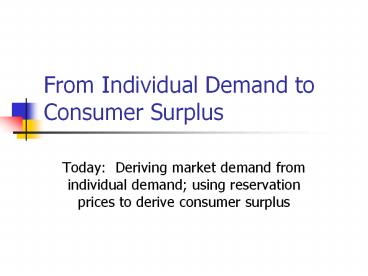From Individual Demand to Consumer Surplus - PowerPoint PPT Presentation
Title:
From Individual Demand to Consumer Surplus
Description:
Area of triangle is one-half times length times height. CS = $9. The area of this triangle is a good approximation of CS. This concludes demand ... – PowerPoint PPT presentation
Number of Views:24
Avg rating:3.0/5.0
Title: From Individual Demand to Consumer Surplus
1
From Individual Demand to Consumer Surplus
- Today Deriving market demand from individual
demand using reservation prices to derive
consumer surplus
2
Recall individual demand
- Last time, we went through the assumptions that
gave us a downward-sloping individual demand
curve - We will use horizontal addition to derive
market demand from all individual demands
3
Example Individual to market demand
Price Shannons quantity demanded Pats quantity demanded
6 0 0
5 2 0
4 4 0
3 6 0
2 8 3
1 10 6
0 12 9
- Suppose Pat and Shannon have the following demand
schedules for apples
4
Example Individual to market demand
- How do we get the market demand from individual
demands? - We add them up
Price Shannons quantity demanded Pats quantity demanded Total demand
6 0 0 0
5 2 0 2
4 4 0 4
3 6 0 6
2 8 3 11
1 10 6 16
0 12 9 21
5
Some graphing reminders
- Some reminders of graphs
- Label axes
- Label dollar amounts, quantities, etc.
- To save space, all quantity numbers here are
apples
6
Graphing demandsShannon (left) Pat (right)
7
Total demand
8
How can we graph demand with only the graphs?
- Another method of graphing total demand from
individual demand is a method called horizontal
addition - We horizontally add quantities demanded from each
person AT A GIVEN PRICE
9
Price greater than 3
- When price is greater than 3, Shannon is the
only person demanding a positive quantity - Thus, the top half of Shannons demand curve is
the same as the markets
10
At 3, 6 0 units are demanded
11
At 0, 12 9 units are demanded
12
Bottom half of the demand curve
- At 3, 6 units are demanded
- At 0, 21 units are demanded
- Bottom half of demand curve connects (6, 3) and
(21, 0)
13
Reservation price and consumer surplus
- How well off are we when we buy something?
- Calculate consumer surplus by using demand curve
and reservation price
14
Reservation price
- Reservation price is the highest price a person
is willing to pay for a good or service - Note that reservation price for the nth unit
corresponds to a particular point of a demand
curve
15
Lets return to part of Shannons demand
- Shannons reservation price for 6th apple is 3
Price Shannons quantity demanded
6 0
5 2
4 4
3 6
16
Calculating consumer surplus
- Consumer surplus (CS) for the nth unit is the
vertical difference between the demand curve and
the price paid - We will calculate CS two ways
- Discretely
- Approximate using area under demand curve
17
Back to Shannon
Price Shannons quantity demanded
6 0
5 2
4 4
3 6
Quantity Reservation price
1st unit 5.50
2nd unit 5
3rd unit 4.50
4th unit 4
5th unit 3.50
6th unit 3
18
If P 3
- At P 3, Shannon demands 6 apples
- To calculate total consumer surplus for Shannon,
we simply add CS for each unit purchased
Quantity Reservation price CS
1st unit 5.50 2.50
2nd unit 5.00 2.00
3rd unit 4.50 1.50
4th unit 4.00 1.00
5th unit 3.50 0.50
6th unit 3.00 0.00
19
CS for 6 units purchased
- CS is the sum of the six dollar amounts in the
right column, or 7.50
Quantity Reservation price CS
1st unit 5.50 2.50
2nd unit 5.00 2.00
3rd unit 4.50 1.50
4th unit 4.00 1.00
5th unit 3.50 0.50
6th unit 3.00 0.00
20
CS from demand curves
- CS can be approximated by calculating the area
under the demand curve and above the price
The area of this triangle is a good approximation
of CS
21
CS from demand curves
- Height of triangle is (6 3), or 3.
- Length of triangle is (6 0), or 6
- Area of triangle is one-half times length times
height - CS 9
The area of this triangle is a good approximation
of CS
22
This concludes demand
- What have we learned?
- How individual demand is derived
- Utility
- The rational spending rule
- Deriving market demand from individual demand
- Consumer surplus
- On your own Read Ch. 5 appendix
- Indifference curves are important in Econ 100A































